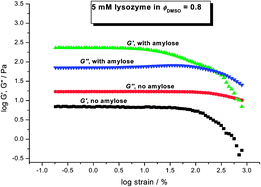Protein–polysaccharide viscoelastic matrices: synergic effects of amylose on lysozyme physical gelation in aqueous dimethylsulfoxide
Abstract
A synergic effect of

* Corresponding authors
a
Departamento de Química Fundamental, Instituto de Química, Universidade de São Paulo, Av. Prof. Lineu Prestes, 748, CEP 05508-000 São Paulo, Brazil
E-mail:
epgareas@usp.br
Fax: (+55) (11) 3815 5579
Tel: (+55) (11) 3091 2165
A synergic effect of

 Please wait while we load your content...
Something went wrong. Try again?
Please wait while we load your content...
Something went wrong. Try again?
W. A. Cruz and E. P. G. Arêas, Soft Matter, 2009, 5, 4240 DOI: 10.1039/B908608K
To request permission to reproduce material from this article, please go to the Copyright Clearance Center request page.
If you are an author contributing to an RSC publication, you do not need to request permission provided correct acknowledgement is given.
If you are the author of this article, you do not need to request permission to reproduce figures and diagrams provided correct acknowledgement is given. If you want to reproduce the whole article in a third-party publication (excluding your thesis/dissertation for which permission is not required) please go to the Copyright Clearance Center request page.
Read more about how to correctly acknowledge RSC content.
 Fetching data from CrossRef.
Fetching data from CrossRef.
This may take some time to load.
Loading related content
